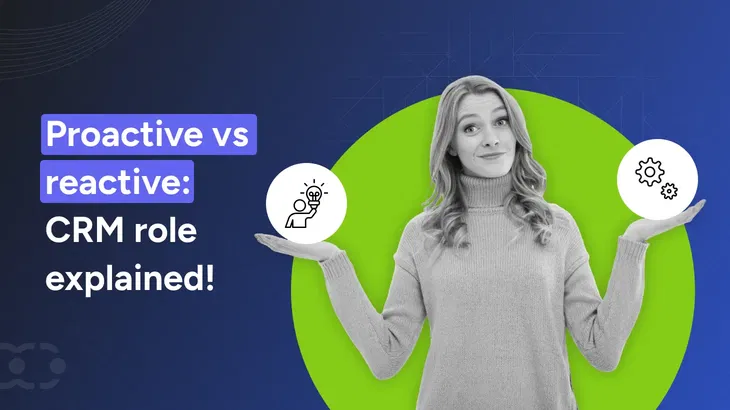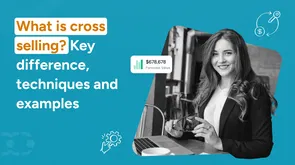In today’s fast-moving business world, how you manage customer relationships can make or break your growth.
When it comes to CRM strategies, teams often face a big question: should you be proactive in anticipating needs and solve problems before they even or reactively wait to respond whenever customers reach out?
The truth is, it's not about choosing one over the other. Both approaches play a vital role in shaping a memorable customer experience.
In this blog, we will break down the proactive vs reactive approach of CRM, explore where each fit in your customer journey, and show you how a smart CRM like Salesmate can help in both methods.
What is proactive vs reactive management?
The reactive and proactive approach can help you strike the right balance to keep customers engaged, loyal, and returning for more. Let's understand both the management styles thoroughly:
-> Proactive management
Proactive management is a forward-thinking approach centered on anticipating potential challenges and opportunities before they arise.
The more proactive manager uses data, trends, and feedback to plan, implement preventive strategies, and drive continuous improvement.
This proactive management style focuses on risk mitigation, operational stability, and long-term efficiency.
Example
A retail store manager anticipates the holiday rush by hiring seasonal staff well in advance, conducting training sessions, and launching early promotional email marketing campaigns.
This proactive preparation ensures smooth operations, reduces last-minute pressure, and maximizes sales during peak season.
-> Reactive management
Reactive management is a response-driven approach where action is taken only after a problem has occurred.
Reactive thinking prioritizes short-term fixes and immediate resolution over preventative planning. While reactive thinking can be effective in crises, it often leads to repeated disruptions if not balanced with longer-term strategies.
Example
A hotel manager responds to guest complaints only after they are reported, offering free stays or discounts as compensation. While this approach may resolve individual issues, it does not address the root causes behind recurring problems.
Reactive vs proactive: A key glance at the difference
Proactive vs reactive approach: take a close look at the image difference table to know both approaches in detail:
Aspect | Proactive management | Reactive management |
Definition | Proactive people or leaders anticipate challenges and opportunities before they arise through planning and foresight. | Reactive personality deals with issues after they surface, often in crisis mode. |
Timing | Measures are implemented in advance to prevent or reduce future risks. | Actions are taken post-event, typically in response to disruptions. |
Focus | Prioritizes long-term goals, continuous improvement, and risk mitigation. | Centered on immediate problem-solving and damage control. |
Control | Greater control through early intervention and structured planning. | Limited control, often dictated by external triggers or emergencies. |
Cost implications | Reduces long-term costs by avoiding unplanned disruptions and resource inefficiencies. | Often higher costs due to last-minute fixes, lost productivity, or customer churn. |
Effectiveness | Delivers sustainable outcomes by aligning processes with strategic business goals. | Effective for short-term fixes but unsustainable for ongoing success. |
Stress levels | Lower stress due to structured workflows and reduced urgency. | High stress from constant firefighting and unexpected challenges. |
Business community | Ensures smoother, uninterrupted operations through preventive measures. | More prone to operational interruptions and service disruptions. |
Collaboration | Encourages cross-functional collaboration during planning and scenario mapping. | Team collaboration is limited; decisions are often made under pressure. |
Adaptability | Adjusts seamlessly to changing environments with data-driven insights. | Reacts to specific problems with limited flexibility or foresight. |
CRM application | CRM is leveraged for behavioral insights, automated follow-ups, and proactive engagement. | CRM is used mainly to log incidents and track responses after they happen. |
Customer experience | Delivers consistent, personalized experiences by resolving issues before they escalate. | Often inconsistent; issues are addressed only after complaints arise. |
Proactive vs reactive mindset: Why does it matter?
Your mindset as a leader shapes how your team works, how your customers feel, and how your business grows.
When managing a business, you can make progress by being proactive rather than reactive. Let's break down why a proactive mindset makes all the difference.
Why does a proactive mindset win in business?
1. Stay ahead of problems
Proactive leaders don't wait for things to happen to go wrong. They spot issues early and fix them before they escalate. This keeps sales operations running smoothly and avoids last-minute chaos.
2. Decisions are smarter and more strategic
Instead of making decisions under pressure, proactive managers rely on data and long-term goals to make decisions. That results in fewer mistakes and more consistent progress toward profitability.
3. Creates space for innovation
You can think big when you are not constantly playing catch-up and dealing with emergencies. A proactive mindset encourages creativity, experimentation, and new ideas that help your business grow exponentially.
4. Teams feel less stressed
Constantly putting out fires wears the team's ability and creates a vicious cycle. Proactive leadership reduces burnout and fosters a supportive work environment, even in high-pressure situations.
5. Customers feel truly valued
You earn trust by anticipating your customers' needs and solving problems before they even notice them. This proactive approach fosters long-term loyalty and enhances customer satisfaction.
What happens with a reactive mindset?
- More stress with less control: You are always playing catch-up, which puts pressure on you and your team, causing unnecessary stress.
- Quick fixes & not a real solution: You deal with symptoms, not root causes, leading to repetitive problems and issues.
- Missed opportunities: By focusing only on the present and immediate needs, you may overlook trends or changes that could give you a competitive edge.
Don't miss this: Top Sales Trends to Watch in 2025: Insights for Sales Professionals
Reactive vs proactive management: pros & cons
The strengths and weaknesses of reactive and proactive management styles are key to finding the right balance for your business. Here's a detailed comparison to help you evaluate each approach in real-world business scenarios:
Pros of reactive management
Although a reactive management style is not always ideal, it still has some advantages. Let's look at the bigger picture:
1. Quick resolution of problems
An ideal solution for situations that require immediate attention, offering fast, efficient responses and ensuring minimal disruption to operations. Reactive managers excel at day-to-day tasks, solving problems on the spot and preventing further escalation.
2. High adaptability
This approach allows teams to pivot quickly in fast-changing environments, making it useful in industries prone to volatility or sudden shifts.
3. Efficient use of current resources
Resources are directed only when problems arise, avoiding the overhead of planning ahead for every potential issue.
4. Strong crisis management skills
Reactive leaders become effective under pressure, honing their decision-making and troubleshooting abilities in high-stakes situations.
Cons of reactive management
Around 76% of employees experience burnout, with excessive and constant firefighting being major contributors. Here are the disadvantages of using the reactive management system:
1. Increased stress and burnout
Constantly working under pressure leads to high stress levels for leaders and team members, impacting morale and productivity.
2. Lack of strategic direction
The focus is on putting out fires, which can pull attention away from long-term goals and sustainable growth.
3. Inconsistent results
Decisions made in haste may address the symptom, not the root cause, resulting in repeated issues or unstable performance.
4. Missed growth opportunities
Without forward-looking strategies, businesses may miss out on trends, innovations, or customer shifts that proactive competitors seize first.
Pros of proactive management
The proactive market is expected to expand significantly, reaching a CAGR of 21.4%, driven by digitization initiatives. Here is how it is beneficial for the businesses:
1. Lower risk exposure
Anticipating issues before they happen helps prevent disruptions, improve companies' stability, and reduce crises' impact.
2. Clear planning and direction
Proactive leaders set long-term goals and develop structured contingency plans, assisting teams to stay aligned and focused on meaningful progress.
3. Boosted employee morale and engagement
A proactive environment encourages team members to contribute ideas, take initiative, and feel more ownership.
4. Foundation for long-term growth
Proactive management builds a solid foundation for a scalable and sustainable business model by focusing on improvement and prevention.
Cons of proactive management
Despite its benefits, the proactive thinking approach has some drawbacks. Let's look through it:
1. Higher upfront resource investment
Planning, analysis, and training often require more time, tools, and budget, making it harder for lean teams or startups to adopt early on.
2. Risk of over-planning
Excessive focus on planning can lead to inflexibility, where teams struggle to adjust quickly when unexpected changes arise.
3. Longer time to see results
Since proactive efforts are geared toward long-term gains, the payoff may not be immediate, requiring patience and stakeholder buy-in.
Proactive vs reactive strategies for businesses!
CRM strategies are crucial in managing customer relationships effectively and adopting proactive or reactive approaches that can significantly impact business success. Below are the detailed strategies for both methods to help businesses thrive:
Proactive CRM strategies
Proactive CRM is all about being a step ahead and coming to conclusions about the problems for the companies. Here are a few strategies to associate for better results:
1. Understand customer needs
Use surveys, feedback forms, and analytics to learn what your customers want. Tools like net promoter score (NPS) can help you spot satisfaction trends and areas for improvement.
2. Leverage predictive analytics
With AI-powered CRM, you can forecast customer behavior, identify churn risks, and personalize communication based on patterns and purchase history.
3. Automate helpful communication
Set up automated messages for order updates, payment reminders, renewal notices, or maintenance alerts. These small touches keep the customers informed and reduce uncertainty.
Interesting read: Gentle Reminder Email: 9 Proven Templates to Get a Response Faster.
4. Self-service resources
Build a knowledge base with FAQs, how-to guides, and video tutorials. Customers appreciate quick, self-driven solutions without needing to reach out.
5. Personalized product suggestions
Use the CRM database to tailor product or service recommendations that match customer interests, increasing engagement and boosting upselling opportunities.
6. Plan for peak times
Analyze past support trends to forecast staffing needs during busy periods. This helps ensure timely responses and avoids long wait times.
7. Current customer data
Regular checkups are needed to update your CRM records and ensure accurate and relevant communications. Outdated information leads to missed opportunities and miscommunication.
8. Train your team
Equip employees with the best CRM practices so they can spot opportunities to engage before issues arise, whether they involve re-engaging a silent customer or sending a timely offer.
Reactive CRM strategies
Reactive CRM comes into play when customers ask questions, complain, or have problems. While they focus on solving immediate external factors, it's also an opportunity to show customers you care and to learn from their experiences:
1. Resolve complaints quickly
Use your CRM to streamline support workflows, route tickets to the right teams, track resolution times, and ensure customers aren't kept waiting.
2. Monitor social media channels
Use social media tools to catch customer concerns on Twitter or LinkedIn. A fast, empathetic response can turn negative feedback into positive experiences.
3. Prioritize support tickets
Let your CRM help solve issues with urgent matters. Tag the tickets, set reminders, and keep a clear timeline so nothing slips through the cracks.
4. Act on feedback
When customers share their thoughts during reactive interactions, log that feedback and close the loop to show them their voice leads to real change.
Simplify the support with the best ticketing software!
Through Salesmate, efficiently manage customer inquiries and ensure timely resolutions with powerful ticketing software
5. Prepared for crises
Use your CRM to map response plans for unexpected situations like service outages, shipping delays, or product recalls. Clear protocols can help teams act fast and stay aligned.
Proactive vs reactive examples
Here are some realistic business examples that highlight the difference between proactive vs. reactive management across various departments like customer service, sales, marketing, operations, and HR:
1. Proactive vs reactive customer service
Proactive
An e-commerce company sends customers automated delivery updates, proactively shares delay notifications, and offers support links before customers ask.
→ Result: Fewer support tickets and increased customer satisfaction.
Reactive
A customer calls the support team without prior notification after their delayed order. The agent apologizes and offers compensation.
→ Result: The issue is resolved, but the customer's trust is already affected.
2. Proactive vs reactive in sales
Proactive
A sales rep notices a client's product usage has dropped and reaches out with a personalized check-in and a new feature demo tailored to their needs.
→ Result: The client stays engaged, and upsell opportunities emerge.
Reactive
The sales team only contacts the customer after they request to cancel their subscription.
→ Result: A last-minute retention effort is made, but the customer is already halfway out.
3. Proactive vs reactive in marketing
Proactive
A marketing team uses predictive analytics to segment customers and launch a seasonal campaign based on buying behavior trends before competitors.
→ Result: Higher engagement, more conversions, and stronger market positioning.
Reactive
The team launched a campaign after noticing a drop in website traffic without prior audience analysis.
→ Result: Slower recovery and lower ROI from the campaign.
4. Proactive vs reactive in operations & IT
Proactive
A SaaS company uses monitoring tools to detect system strain and deploys updates during off-peak hours. They also schedule regular maintenance using a CMMS.
→ Result: Uptime is maintained, and user experience is uninterrupted.
Reactive
A system crashes during peak usage, and the team scrambles to fix it under pressure.
→ Result: Revenue loss, downtime, and customer complaints.
5. Proactive vs reactive in human resources
Proactive
HR surveys quarterly to assess employee satisfaction, spot early burnout signs, and roll out flexible work initiatives.
→ Result: Improved retention and a more engaged workforce.
Reactive
HR responds only after multiple resignations and then conducts exit interviews to understand why.
→ Result: Damage is already done, and the team suffers from knowledge loss and low morale
Salesmate: Your path to proactive success
Salesmate offers a powerful suite of automation & AI-driven tools that help businesses move beyond reactive responses and embrace a more proactive, strategic approach to operations. It equips teams with everything they need to anticipate problems, engage customers meaningfully, and operate efficiently. Here are the features:
- Automated workflows: Eliminate repetitive manual tasks by automating follow-ups, email sequences, and dealing with assignments.
- Reporting: Leverage built-in analytics to forecast pipeline health, win probabilities, and get better customer retention.
- Sandy AI: Sandy AI can help enable automating tasks, personalizing communications, and more to streamline workflows.
- Lead scoring: Focus your efforts on high-intent prospects most likely to convert, increasing sales velocity and team efficiency.
- Live chat: Engage website visitors with proactive chat prompts triggered by user behavior.
- Sequences: Design multi-channel sequences (emails, calls, tasks) to ensure consistent engagement throughout the customer journey.
- Marketing automation: Run drip campaigns and ABM strategies that nurture prospects across multiple touchpoints.
Ready to switch from reactive to proactive!
With Salesmate, you can automate follow-ups, track behaviors, and anticipate customer needs while still being ready for whatever comes your way
Wrap up!
The key isn't which is better, but how to balance the proactive vs reactive approach to achieve optimal results. The real value lies in finding the right balance between them.
By combining proactive planning with reactive agility, businesses can build stronger customer relationships, streamline operations, and confidently respond to change.
Whether through strategic goal setting, risk anticipation, or smart resource allocation, shifting toward a more proactive mindset supported by the right tools empowers teams to lead rather than follow.
With platforms like Salesmate, you don't have to choose between the two. You can anticipate customer needs, automate smart workflows, and respond in real time, all within a single CRM.
Frequently asked questions!
1) How can a business transition from reactive to proactive management?
Shifting from a reactive to a proactive management approach requires international planning, skill development, and a mindset change in the organization. Here is how businesses can make that transition effectively:
- Define clear long-term goals
- Invest in strategic planning
- Equip teams for proactive training
- Foster a culture of continuous planning
- Balance proactive planning with reactive agility
2) How can businesses balance proactive and reactive strategies?
Businesses can strike the right balance instead of choosing reactive vs. proactive by setting long-term goals while staying flexible and adapting.
Proactively identifying risks and preparing mitigation plans ensures stability while maintaining readiness for quick, reactive responses builds agility.
Allocating resources wisely between strategic initiatives and operational responsiveness helps teams stay prepared on both fronts. Finally, learning from reactive scenarios allows businesses to refine their proactive approach, fostering resilience and growth continuously.
3) Can you provide examples of proactive vs. reactive behaviors in the workplace?
The example of proactive vs reactive behavior in the workplace:
Proactive Behaviors:
-
Anticipating challenges: Planning to avoid potential delays or risks.
-
Taking initiative: Proposing ideas or improvements without being asked.
-
Seeking feedback: Actively asking for input to grow and improve.
-
Long-term planning: Setting clear goals aligned with company objectives.
-
Investing in skills: Continuously learning to stay ahead in the industry.
Reactive Behaviors:
-
Crisis management: Handling problems only when they arise, often under pressure.
-
Last-minute problem-solving: Fixing issues after they've caused disruption.
-
Responding to prompts: Acting only when reminded or instructed.
-
Quick adaptation: Adjusting to unexpected changes on the spot.
4) How do proactive and reactive management styles affect team dynamics?
The impact of proactive vs reactive in business can be crucial for future growth:
Proactive management
- Boosts morale and engagement
- Ensures clear communication
- Drives skill development
- Builds trust and empowerment
- Focuses on long-term success
Reactive management
- Creates a high-stress environment
- Lowers morale
- This leads to poor communication
- Limits professional growth
- Encourages short-term thinking







Key takeaways
In today’s fast-moving business world, how you manage customer relationships can make or break your growth.
When it comes to CRM strategies, teams often face a big question: should you be proactive in anticipating needs and solve problems before they even or reactively wait to respond whenever customers reach out?
The truth is, it's not about choosing one over the other. Both approaches play a vital role in shaping a memorable customer experience.
In this blog, we will break down the proactive vs reactive approach of CRM, explore where each fit in your customer journey, and show you how a smart CRM like Salesmate can help in both methods.
What is proactive vs reactive management?
The reactive and proactive approach can help you strike the right balance to keep customers engaged, loyal, and returning for more. Let's understand both the management styles thoroughly:
-> Proactive management
Proactive management is a forward-thinking approach centered on anticipating potential challenges and opportunities before they arise.
The more proactive manager uses data, trends, and feedback to plan, implement preventive strategies, and drive continuous improvement.
This proactive management style focuses on risk mitigation, operational stability, and long-term efficiency.
Example
A retail store manager anticipates the holiday rush by hiring seasonal staff well in advance, conducting training sessions, and launching early promotional email marketing campaigns.
This proactive preparation ensures smooth operations, reduces last-minute pressure, and maximizes sales during peak season.
-> Reactive management
Reactive management is a response-driven approach where action is taken only after a problem has occurred.
Reactive thinking prioritizes short-term fixes and immediate resolution over preventative planning. While reactive thinking can be effective in crises, it often leads to repeated disruptions if not balanced with longer-term strategies.
Example
A hotel manager responds to guest complaints only after they are reported, offering free stays or discounts as compensation. While this approach may resolve individual issues, it does not address the root causes behind recurring problems.
Reactive vs proactive: A key glance at the difference
Proactive vs reactive approach: take a close look at the image difference table to know both approaches in detail:
Aspect
Proactive management
Reactive management
Definition
Proactive people or leaders anticipate challenges and opportunities before they arise through planning and foresight.
Reactive personality deals with issues after they surface, often in crisis mode.
Timing
Measures are implemented in advance to prevent or reduce future risks.
Actions are taken post-event, typically in response to disruptions.
Focus
Prioritizes long-term goals, continuous improvement, and risk mitigation.
Centered on immediate problem-solving and damage control.
Control
Greater control through early intervention and structured planning.
Limited control, often dictated by external triggers or emergencies.
Cost implications
Reduces long-term costs by avoiding unplanned disruptions and resource inefficiencies.
Often higher costs due to last-minute fixes, lost productivity, or customer churn.
Effectiveness
Delivers sustainable outcomes by aligning processes with strategic business goals.
Effective for short-term fixes but unsustainable for ongoing success.
Stress levels
Lower stress due to structured workflows and reduced urgency.
High stress from constant firefighting and unexpected challenges.
Business community
Ensures smoother, uninterrupted operations through preventive measures.
More prone to operational interruptions and service disruptions.
Collaboration
Encourages cross-functional collaboration during planning and scenario mapping.
Team collaboration is limited; decisions are often made under pressure.
Adaptability
Adjusts seamlessly to changing environments with data-driven insights.
Reacts to specific problems with limited flexibility or foresight.
CRM application
CRM is leveraged for behavioral insights, automated follow-ups, and proactive engagement.
CRM is used mainly to log incidents and track responses after they happen.
Customer experience
Delivers consistent, personalized experiences by resolving issues before they escalate.
Often inconsistent; issues are addressed only after complaints arise.
Proactive vs reactive mindset: Why does it matter?
Your mindset as a leader shapes how your team works, how your customers feel, and how your business grows.
When managing a business, you can make progress by being proactive rather than reactive. Let's break down why a proactive mindset makes all the difference.
Why does a proactive mindset win in business?
1. Stay ahead of problems
Proactive leaders don't wait for things to happen to go wrong. They spot issues early and fix them before they escalate. This keeps sales operations running smoothly and avoids last-minute chaos.
2. Decisions are smarter and more strategic
Instead of making decisions under pressure, proactive managers rely on data and long-term goals to make decisions. That results in fewer mistakes and more consistent progress toward profitability.
3. Creates space for innovation
You can think big when you are not constantly playing catch-up and dealing with emergencies. A proactive mindset encourages creativity, experimentation, and new ideas that help your business grow exponentially.
4. Teams feel less stressed
Constantly putting out fires wears the team's ability and creates a vicious cycle. Proactive leadership reduces burnout and fosters a supportive work environment, even in high-pressure situations.
5. Customers feel truly valued
You earn trust by anticipating your customers' needs and solving problems before they even notice them. This proactive approach fosters long-term loyalty and enhances customer satisfaction.
What happens with a reactive mindset?
Reactive vs proactive management: pros & cons
The strengths and weaknesses of reactive and proactive management styles are key to finding the right balance for your business. Here's a detailed comparison to help you evaluate each approach in real-world business scenarios:
Pros of reactive management
Although a reactive management style is not always ideal, it still has some advantages. Let's look at the bigger picture:
1. Quick resolution of problems
An ideal solution for situations that require immediate attention, offering fast, efficient responses and ensuring minimal disruption to operations. Reactive managers excel at day-to-day tasks, solving problems on the spot and preventing further escalation.
2. High adaptability
This approach allows teams to pivot quickly in fast-changing environments, making it useful in industries prone to volatility or sudden shifts.
3. Efficient use of current resources
Resources are directed only when problems arise, avoiding the overhead of planning ahead for every potential issue.
4. Strong crisis management skills
Reactive leaders become effective under pressure, honing their decision-making and troubleshooting abilities in high-stakes situations.
Cons of reactive management
Around 76% of employees experience burnout, with excessive and constant firefighting being major contributors. Here are the disadvantages of using the reactive management system:
1. Increased stress and burnout
Constantly working under pressure leads to high stress levels for leaders and team members, impacting morale and productivity.
2. Lack of strategic direction
The focus is on putting out fires, which can pull attention away from long-term goals and sustainable growth.
3. Inconsistent results
Decisions made in haste may address the symptom, not the root cause, resulting in repeated issues or unstable performance.
4. Missed growth opportunities
Without forward-looking strategies, businesses may miss out on trends, innovations, or customer shifts that proactive competitors seize first.
Pros of proactive management
The proactive market is expected to expand significantly, reaching a CAGR of 21.4%, driven by digitization initiatives. Here is how it is beneficial for the businesses:
1. Lower risk exposure
Anticipating issues before they happen helps prevent disruptions, improve companies' stability, and reduce crises' impact.
2. Clear planning and direction
Proactive leaders set long-term goals and develop structured contingency plans, assisting teams to stay aligned and focused on meaningful progress.
3. Boosted employee morale and engagement
A proactive environment encourages team members to contribute ideas, take initiative, and feel more ownership.
4. Foundation for long-term growth
Proactive management builds a solid foundation for a scalable and sustainable business model by focusing on improvement and prevention.
Cons of proactive management
Despite its benefits, the proactive thinking approach has some drawbacks. Let's look through it:
1. Higher upfront resource investment
Planning, analysis, and training often require more time, tools, and budget, making it harder for lean teams or startups to adopt early on.
2. Risk of over-planning
Excessive focus on planning can lead to inflexibility, where teams struggle to adjust quickly when unexpected changes arise.
3. Longer time to see results
Since proactive efforts are geared toward long-term gains, the payoff may not be immediate, requiring patience and stakeholder buy-in.
Proactive vs reactive strategies for businesses!
CRM strategies are crucial in managing customer relationships effectively and adopting proactive or reactive approaches that can significantly impact business success. Below are the detailed strategies for both methods to help businesses thrive:
Proactive CRM strategies
Proactive CRM is all about being a step ahead and coming to conclusions about the problems for the companies. Here are a few strategies to associate for better results:
1. Understand customer needs
Use surveys, feedback forms, and analytics to learn what your customers want. Tools like net promoter score (NPS) can help you spot satisfaction trends and areas for improvement.
2. Leverage predictive analytics
With AI-powered CRM, you can forecast customer behavior, identify churn risks, and personalize communication based on patterns and purchase history.
3. Automate helpful communication
Set up automated messages for order updates, payment reminders, renewal notices, or maintenance alerts. These small touches keep the customers informed and reduce uncertainty.
4. Self-service resources
Build a knowledge base with FAQs, how-to guides, and video tutorials. Customers appreciate quick, self-driven solutions without needing to reach out.
5. Personalized product suggestions
Use the CRM database to tailor product or service recommendations that match customer interests, increasing engagement and boosting upselling opportunities.
6. Plan for peak times
Analyze past support trends to forecast staffing needs during busy periods. This helps ensure timely responses and avoids long wait times.
7. Current customer data
Regular checkups are needed to update your CRM records and ensure accurate and relevant communications. Outdated information leads to missed opportunities and miscommunication.
8. Train your team
Equip employees with the best CRM practices so they can spot opportunities to engage before issues arise, whether they involve re-engaging a silent customer or sending a timely offer.
Reactive CRM strategies
Reactive CRM comes into play when customers ask questions, complain, or have problems. While they focus on solving immediate external factors, it's also an opportunity to show customers you care and to learn from their experiences:
1. Resolve complaints quickly
Use your CRM to streamline support workflows, route tickets to the right teams, track resolution times, and ensure customers aren't kept waiting.
2. Monitor social media channels
Use social media tools to catch customer concerns on Twitter or LinkedIn. A fast, empathetic response can turn negative feedback into positive experiences.
3. Prioritize support tickets
Let your CRM help solve issues with urgent matters. Tag the tickets, set reminders, and keep a clear timeline so nothing slips through the cracks.
4. Act on feedback
When customers share their thoughts during reactive interactions, log that feedback and close the loop to show them their voice leads to real change.
Simplify the support with the best ticketing software!
Through Salesmate, efficiently manage customer inquiries and ensure timely resolutions with powerful ticketing software
5. Prepared for crises
Use your CRM to map response plans for unexpected situations like service outages, shipping delays, or product recalls. Clear protocols can help teams act fast and stay aligned.
Proactive vs reactive examples
Here are some realistic business examples that highlight the difference between proactive vs. reactive management across various departments like customer service, sales, marketing, operations, and HR:
1. Proactive vs reactive customer service
Proactive
An e-commerce company sends customers automated delivery updates, proactively shares delay notifications, and offers support links before customers ask.
→ Result: Fewer support tickets and increased customer satisfaction.
Reactive
A customer calls the support team without prior notification after their delayed order. The agent apologizes and offers compensation.
→ Result: The issue is resolved, but the customer's trust is already affected.
2. Proactive vs reactive in sales
Proactive
A sales rep notices a client's product usage has dropped and reaches out with a personalized check-in and a new feature demo tailored to their needs.
→ Result: The client stays engaged, and upsell opportunities emerge.
Reactive
The sales team only contacts the customer after they request to cancel their subscription.
→ Result: A last-minute retention effort is made, but the customer is already halfway out.
3. Proactive vs reactive in marketing
Proactive
A marketing team uses predictive analytics to segment customers and launch a seasonal campaign based on buying behavior trends before competitors.
→ Result: Higher engagement, more conversions, and stronger market positioning.
Reactive
The team launched a campaign after noticing a drop in website traffic without prior audience analysis.
→ Result: Slower recovery and lower ROI from the campaign.
4. Proactive vs reactive in operations & IT
Proactive
A SaaS company uses monitoring tools to detect system strain and deploys updates during off-peak hours. They also schedule regular maintenance using a CMMS.
→ Result: Uptime is maintained, and user experience is uninterrupted.
Reactive
A system crashes during peak usage, and the team scrambles to fix it under pressure.
→ Result: Revenue loss, downtime, and customer complaints.
5. Proactive vs reactive in human resources
Proactive
HR surveys quarterly to assess employee satisfaction, spot early burnout signs, and roll out flexible work initiatives.
→ Result: Improved retention and a more engaged workforce.
Reactive
HR responds only after multiple resignations and then conducts exit interviews to understand why.
→ Result: Damage is already done, and the team suffers from knowledge loss and low morale
Salesmate: Your path to proactive success
Salesmate offers a powerful suite of automation & AI-driven tools that help businesses move beyond reactive responses and embrace a more proactive, strategic approach to operations. It equips teams with everything they need to anticipate problems, engage customers meaningfully, and operate efficiently. Here are the features:
Ready to switch from reactive to proactive!
With Salesmate, you can automate follow-ups, track behaviors, and anticipate customer needs while still being ready for whatever comes your way
Wrap up!
The key isn't which is better, but how to balance the proactive vs reactive approach to achieve optimal results. The real value lies in finding the right balance between them.
By combining proactive planning with reactive agility, businesses can build stronger customer relationships, streamline operations, and confidently respond to change.
Whether through strategic goal setting, risk anticipation, or smart resource allocation, shifting toward a more proactive mindset supported by the right tools empowers teams to lead rather than follow.
With platforms like Salesmate, you don't have to choose between the two. You can anticipate customer needs, automate smart workflows, and respond in real time, all within a single CRM.
Frequently asked questions!
1) How can a business transition from reactive to proactive management?
Shifting from a reactive to a proactive management approach requires international planning, skill development, and a mindset change in the organization. Here is how businesses can make that transition effectively:
2) How can businesses balance proactive and reactive strategies?
Businesses can strike the right balance instead of choosing reactive vs. proactive by setting long-term goals while staying flexible and adapting.
Proactively identifying risks and preparing mitigation plans ensures stability while maintaining readiness for quick, reactive responses builds agility.
Allocating resources wisely between strategic initiatives and operational responsiveness helps teams stay prepared on both fronts. Finally, learning from reactive scenarios allows businesses to refine their proactive approach, fostering resilience and growth continuously.
3) Can you provide examples of proactive vs. reactive behaviors in the workplace?
The example of proactive vs reactive behavior in the workplace:
Proactive Behaviors:
Anticipating challenges: Planning to avoid potential delays or risks.
Taking initiative: Proposing ideas or improvements without being asked.
Seeking feedback: Actively asking for input to grow and improve.
Long-term planning: Setting clear goals aligned with company objectives.
Investing in skills: Continuously learning to stay ahead in the industry.
Reactive Behaviors:
Crisis management: Handling problems only when they arise, often under pressure.
Last-minute problem-solving: Fixing issues after they've caused disruption.
Responding to prompts: Acting only when reminded or instructed.
Quick adaptation: Adjusting to unexpected changes on the spot.
4) How do proactive and reactive management styles affect team dynamics?
The impact of proactive vs reactive in business can be crucial for future growth:
Proactive management
Reactive management
Juhi Desai
Content WriterJuhi is a passionate writer and reader. She is working with the team of content creators at Salesmate. Always seeking to learn something new, Juhi has an optimistic approach towards life. When she is not writing you can find her with a book and a coffee by her side.